Jan's Working with Windows:
Files & Folders: Exercise Win 2-2
Sometimes you save a document and fail to notice what folder it was saved in. Or perhaps you create a clever scheme one day for storing your files, but a week later you forget what you put where. You need help in finding your files. Windows has a wonderful tool search tool to assist you.
With Search you can search for a file or folder by name, by a partial name, by text contained in the file, or by date or range of dates. It's actually rather flexible.
![]() Special
characters for Search: Windows search lets you use wildcard characters as placeholders in the search term. The asterisk * stands for any number of characters. A question mark ? stands
in for a single character. So if you search for b*.txt the results would include all of the files with an extension of txt whose names start with a b. If you search for ??.bmp,
the results must have exactly two characters before the dot, like ad.bmp and my.bmp. Longer or shorter names would not show, like forest.bmp or f.bmp because they don't have the correct number of letters.
Special
characters for Search: Windows search lets you use wildcard characters as placeholders in the search term. The asterisk * stands for any number of characters. A question mark ? stands
in for a single character. So if you search for b*.txt the results would include all of the files with an extension of txt whose names start with a b. If you search for ??.bmp,
the results must have exactly two characters before the dot, like ad.bmp and my.bmp. Longer or shorter names would not show, like forest.bmp or f.bmp because they don't have the correct number of letters.
Exercise Win2-2: Find and Manage Files
| What you will do: |
|
Start with: ![]()
![]() and have finished Exercise Win2-1.
and have finished Exercise Win2-1.
Look for Files
Windows lets you search for files based on the file's name or its contents or type or date created or date modified. But to see those choices you have to dig a bit in some versions. You will be using the search feature in a Computer or File Explorer window.
Windows 8 has a cool search pane in the Metro/Modern interface, but it will not let restrict your search to particular locations and it only shows the first 250 or so results. But, it is faster than seaching in File Explorer.
You can do most file management tasks directly from the results window. This is so neat!
- Search for files with the extension BMP:
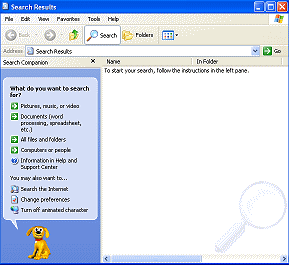
 WinXP:
WinXP:
Click the Start menu and select .
The Search Companion dialog box appears. You will get a Search Results window with the Search pane on the left.The Search button
 on the toolbar toggles this
pane in and out of view. WinXP lets you search for just pictures, or just documents, or all files and folders.
on the toolbar toggles this
pane in and out of view. WinXP lets you search for just pictures, or just documents, or all files and folders. - Inspect all of the choices
for how you can restrict your search.
You may not see the animated dog Rover if the preferences have been changed. At the bottom of the list is a choice to Turn off animated character. The link Change preferences lets you switch to another character in addition to other kinds of preferences. - Select to search All files and folders
- In the text box All or part of the file name, type *.bmp
(Be careful to type this exactly as written - an asterisk, a period, the letters b m p with no spaces.) - In the Look in text box, drop the list and select drive C.
- Click the Advanced options box and then in the box for Search system folders.
There are some bitmap images in the Windows folder that we want to show up in the results.  Click the button Search
Now.
Click the button Search
Now.
As files are found, they are listed for you. This process can take quite a while if your hard disk is large. The default for WinXP is to show thumbnails for pictures. In Details view you can see a more files at once. You can click the Stop Search button in the left pane once the Windows folder has been searched.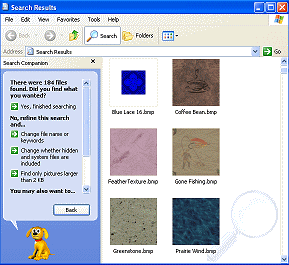
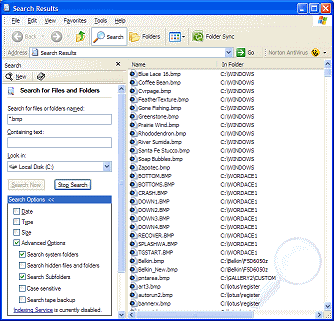
Search results in WinXP -
with Search Companion (Thumbnails) and without Search Companion (Details)

 Vista, Win7:
Vista, Win7:
- Click on the Start menu.
The Search box is directly above the Start button.  Type in the Search box, *.bmp
Type in the Search box, *.bmp
From the Search text box you will automatically be looking in all of the Indexed locations, which includes all of your user folders like Pictures, Documents, and Music but not your removable drives.- Press ENTER.
The results from the Indexed locations appear very quickly above the Start button if it is a short list. But there are many more files than these! - Click at the bottom
of the menu on the link 'See all results'.
Vista and Win7 work differently at this point. -
 Vista: A new Search results window appears and gradually
displays other files as Search looks in locations that were not indexed,
including the Windows folder. (You can stop the search after it finishes with
the Windows folder by clicking the button
Vista: A new Search results window appears and gradually
displays other files as Search looks in locations that were not indexed,
including the Windows folder. (You can stop the search after it finishes with
the Windows folder by clicking the button  at the right end of the progress bar.)
at the right end of the progress bar.)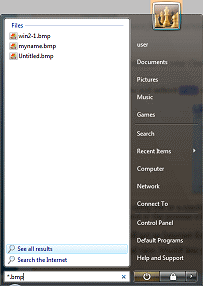
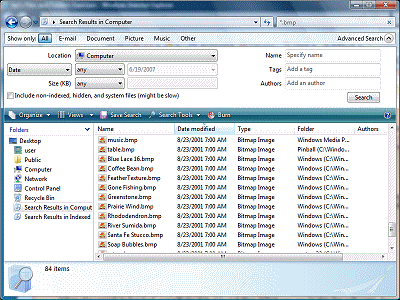
Search results in Windows Vista-
Indexed locations at left and All of Computer at right
(Your results will be different!)If your results for Indexed locations was a long list, it may have opened up in a new window. To see "all results" is not as simple from this window.
Click the Advanced Search button at the upper right of the window, which opens the Search pane.
Inspect the ways in which you can modify the search - location, type, date, etc.
Check the box for "include non-indexed, hidden, and system folders" .
Click on the Search button.
Watch the folder names for where Search is looking. Once it has finished with the Windows folder, you can stop the search process by clicking the button
 .
.
(If the search is taking a long time, you can change the search location to just the Windows folder by navigating through the Locations dialog.) -
 Win7: The new window for 'See more result's still shows only Indexed Locations,
but now you can scroll to see all of them.
Win7: The new window for 'See more result's still shows only Indexed Locations,
but now you can scroll to see all of them.



 Win8, Win8.1:
Win8, Win8.1:
- Open a File Explorer window.
- Select the icon for drive C: in the folder tree.
-
In the search text box at the top right of the window, type *.bmp.
Windows starts looking for files with an extension of bmp. The address bar shows a green progress bar overlay. The search is not finished until the whole address bar is green, including the X box at its right end.My own Windows 8 computer had 187 GB of files on drive C. The search took 4 minutes and 15 seconds and found over 4000 BMP files.
-
Click in the search box.
The Search ribbon tab appears. This is a context-sensitive ribbon tab that only shows when you are searching.
-
Inspect the ribbon buttons to see in what ways you can restrict the search results.
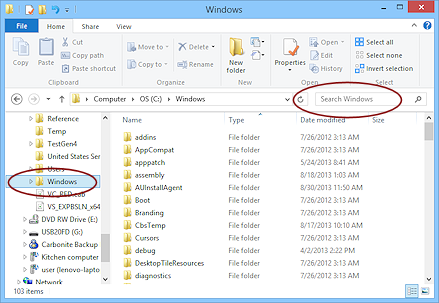 Navigate the folder tree until you can click on the Windows folder.
Navigate the folder tree until you can click on the Windows folder.
The Contents pane changes to show what is contained in the Windows folder.
The search box changes to show "Search Windows".
The Search Tools ribbon tab vanishes when you click on the Windows folder.
 Click in the search box at the upper right.
Click in the search box at the upper right.
A list of recent search terms drops.
If the list does not drop, type the asterisk, *.
The Search Tools tab comes back!
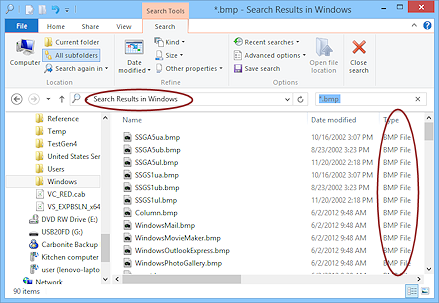 Click on *.bmp.
Now Search looks in just the Windows folder for BMP type files.
Click on *.bmp.
Now Search looks in just the Windows folder for BMP type files.
 Be patient! A
search can take several minutes. The Address Bar (except for WinXP) acts as a
progress bar by turning green from left to right as the search proceeds.
Be patient! A
search can take several minutes. The Address Bar (except for WinXP) acts as a
progress bar by turning green from left to right as the search proceeds.
-
When the search is finished, scroll the list of found files.
What you see in this list will vary with the version of Windows.The column for folder names may be out of sight to the right. If so, slide the horizontal scroll bar across the bottom of the window to see the Folder column. The results are usually grouped by folder. Can you tell by the folder names how these bitmap images are going to be used?
-
Change the display to show Large Icons.
Some files may not show a thumbnail but normal BMP files will.
Copy Files: Send To
-
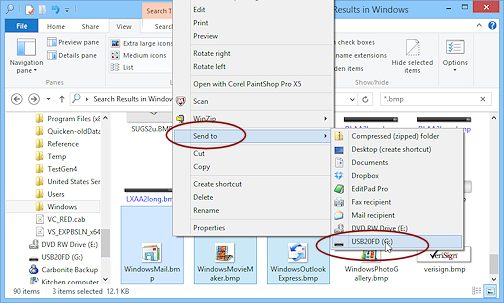 Select three images in the Files Found/Search Results window.
Select three images in the Files Found/Search Results window.Each version of Windows will show different BMP files. The files are mostly images that are used as part of the interface, like for buttons, backgrounds, file icons, or different types of printers.
 Right
click on the selection.
Right
click on the selection. - From the context menu, hover over and from the menu that cascades from it,
select your removable drive.
The selected files are immediately copied to the root of the chosen drive (not in any of the folders). With this method, you cannot browse to a folder on the drive. The window does not change to show you the location of your copies! You must be prepared to remember the location!! Problem: No
command Send to
Problem: No
command Send to
Solution: Copy the files and paste them to your removable drive at the top level, called the root.
- Do NOT close the Search results window.
You need it to be open for later steps.
Create Folder; Save As
- Open a new Computer or File Explorer window.
- Create a new folder, named bitmaps on your removable disk.
- Move the three files from the root directory of the Class disk to the new folder.
- Display the contents of bitmaps in the window.
- On the folder tree, rename the folder as BMP.
In earlier versions of Windows, you did not get all caps when you typed BMP in all caps! - Open a file in Paint:
Right click on one of the images that you copied to your Class disk and select .
The picture opens in Paint. Problem: Image
opens in an image viewer like Windows Picture and Fax Viewer or in Windows
Photo Gallery.
Problem: Image
opens in an image viewer like Windows Picture and Fax Viewer or in Windows
Photo Gallery.
Cause: You double-clicked which selects the default menu item, Preview, or you clicked on Preview in the context menu.
Solution: Close the viewer window and try again. Problem: Image
opens in another graphics program
Problem: Image
opens in another graphics program
Cause: Most graphics programs change the file associations when they are installed to open all images in that program.
Solution: You can try to work with it there if you are familiar with it, or else close that program and use the Open with... command on the context menu. - If necessary, drag the bottom right corner of the image in Paint down and right to enlarge the canvas enough to hold some text.
-
Use the Text tool
 to write your name and Win2-2 on the picture using
a color that contrasts well with the image. Use Braggadocio
or Britannic Bold or another font with large wide letters at a font size that
shows well and fits on the canvas.
to write your name and Win2-2 on the picture using
a color that contrasts well with the image. Use Braggadocio
or Britannic Bold or another font with large wide letters at a font size that
shows well and fits on the canvas.
 The newer versions of Windows come with many more fonts than WinXP, but not quite the same ones
as each other!
Some of the new fonts are primarily for languages that do no use the Latin
alphabet that English uses, like Arabic, Hindi, Japanese, Chinese, Hebrew, and
Thai. Such fonts may all look the same for text in English.
The newer versions of Windows come with many more fonts than WinXP, but not quite the same ones
as each other!
Some of the new fonts are primarily for languages that do no use the Latin
alphabet that English uses, like Arabic, Hindi, Japanese, Chinese, Hebrew, and
Thai. Such fonts may all look the same for text in English. - Use to save the file under a new name in the BMP folder, ex2-FirstName-LastName.bmp, using your own first and last names, of course.
-
Check the Page Setup and Print Preview.
Make adjustments, if necessary, to print the image at the upper left of the page at 100% to 300% of normal size, depending on the size of your image.Examples:
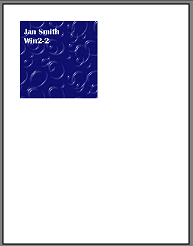
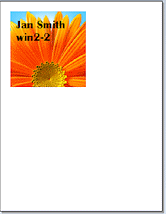
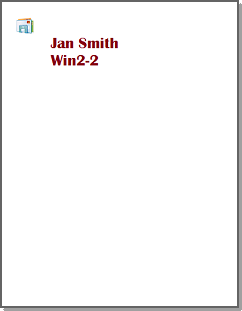
-
 If all is
arranged happily, print.
If all is
arranged happily, print. - Do NOT close Paint.
Refresh; Delete; Cascade; Backup
- Switch back to Explorer with ALT + TAB.
Notice that your file is at the bottom of the list. It is not in alphabetical order! - Refresh the list with one of the following methods:
- Method 1: Press the F5 key.
- Method 2: Use > from the menu
- Method 3: Click the Refresh button

 at the end of the Address box.
at the end of the Address box.
- Delete the original of the file you edited from the folder BMP on
your removable disk.
(Don't delete the original on the hard disk!!!)
-
Cascade the windows: Right click on the Taskbar and choose .
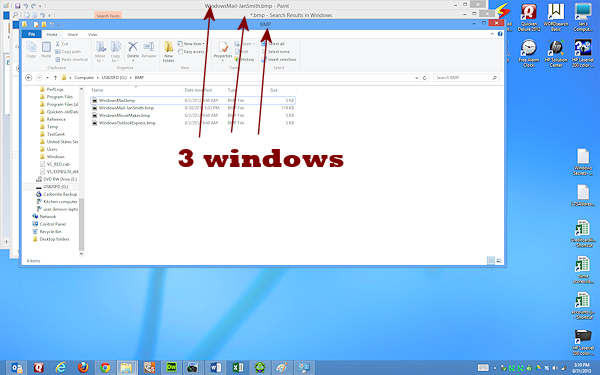
You should have at least 3 windows open - Paint, a Computer or File Explorer window showing your removable drive, and another one showing the search results (and likely a browser with these directions!).
Windows that are minimized will not show in the cascade.
Screen Capture
You can use a screen capture to show someone later what you saw on your screen. This is handy for many technical support issues and also for proving you made those high scores in your favorite games!
You can reduce the size of the file by cropping the image.
- Capture an image of the whole desktop with Print Screen.
- Open a new Paint window by starting Paint again.
- Paste your screen capture.
-
Crop: Use the Select tool to select the part you want to save, then click
 the Crop button, if your version has one. Be sure to include the top left area, which shows the
titles in the title bar.
the Crop button, if your version has one. Be sure to include the top left area, which shows the
titles in the title bar.
No crop button: If your version of Paint does not have a crop button, copy the selection and then open a new document and paste.
- Type your name and Win2-2
somewhere on the image. Be sure it is readable. Don't cover anything that
will make it clear which window is which.
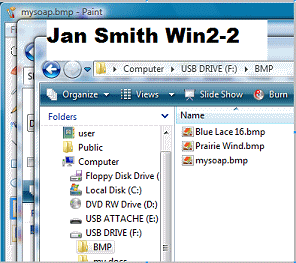
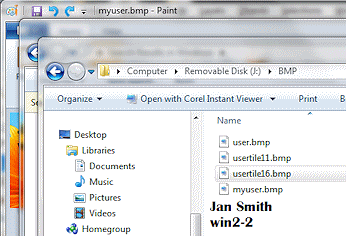

-
 Save the file as win2-2.bmp in the folder win project2.
Save the file as win2-2.bmp in the folder win project2.
- Check Page Setup and Print Preview. Be
sure the image will fit on one page. Make changes if needed.
 Problem: Image is
too wide for the paper
Problem: Image is
too wide for the paper
Solution: Try changing the margins. If it is still too wide, either print 1 page, or go back to Paint and select enough of the image, to show the right pane contents and the title bars of the cascaded windows, crop the image or copy and paste into a new document. Check settings for this version.  Print. Check your printout.
Print. Check your printout.
Backup

 Copy your files to a folder on your hard disk
and/or to a different
removable drive.
Copy your files to a folder on your hard disk
and/or to a different
removable drive.
- Close all of the windows.
